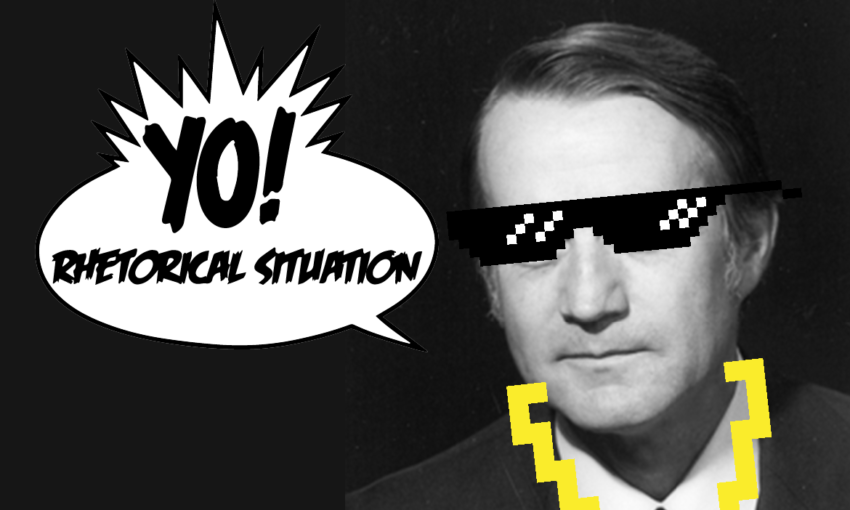I’ve written before about how to use rhetorical practices like the Toulmin Model to structure better arguments. And sure, having a coherent argument will absolutely help you get your point across clearer. But one area I often see people struggle in is understanding context. The foundation of any good argument begins with an understanding of the situation that surrounds it.
Let’s say you’re trying to persuade your friends that dryer sheets are sexy. Well, before you can begin, you need to know why you’re arguing in the first place, who you’re trying to persuade, and what tools of persuasion you have at your disposal.
Enter: my man, Lloyd F. Bitzer a.k.a. LL Cool Bitzer a.k.a. the Wise Professor.
In the late 1960s, Bitzer introduced the world to the oft overlooked “Rhetorical Situation” 1. We knew what rhetoric was ever since Aristotle explained it to us over 2,000 years ago. It’s “the faculty of observing in any given case the available means of persuasion” 2. But what no one ever considered was how the circumstances surrounding rhetoric can affect and define it.
The Exigence Causes Your Argument
The rhetorical situation begins with the problem that needs a solution. The question that needs an answer. The cause. In movie-making they call it “the inciting incident”. I just think of it as the thing that needs fixing. But Bitzer calls it the exigence and defines it as:
…an imperfection marked by urgency;…a defect, an obstacle, something waiting to be done, a thing which is other than it should be.
If you’re making an argument, there must be a thing that caused you to want to make the argument in the first place, doesn’t there? Let’s say you’re trying to convince your friends that dryer sheets are sexy. Our exigence might be, the practice of courtship and mating is complicated and treacherous. Therefore our argument becomes, why not employ a carefully placed dryer sheet to draw positive attention from potential mates?
The Audience Defines Your Argument
Hey! Here’s a thing I hear every time I ask someone who their audience is and totally hasn’t gotten annoying: “Well, my audience is everyone.” No it isn’t. Stop saying that. Your audience defines how you approach an argument, and it is never everyone.
I get it. You have something important to say and you want the whole world to hear it, but Bitzer offers us one way to narrow that focus: An audience needs to be people who can act on the exigence. They are not simply “a body of mere hearers or readers”. Instead:
…a rhetorical audience consists only of those persons who are capable of being influenced by discourse and of being mediators of change.
So taking our example from before: If the exigence of your argument is courtship is difficult, and your argument is employing a clinging dryer sheet will suggest cleanliness, domestic competence and a lovable goof persona to possible mates, then your audience must be people looking for love in all the wrong places. They are the “mediators of change” capable of acting on the exigence. Therefore in your argument, you have no reason to address people who are already in lasting relationships or those lucky Casanovas out there who do not believe that courtship is difficult.
These are all ways of narrowing your audience from the vague everyone to something much more constructive.
The Constraints Shape Your Argument
We understand our exigence, we know our audience, but what we still need to consider are those constraints that come along with an audience. And here’s where the fun begins. Bitzer defines constraints as:
…persons, events, objects, and relations which are parts of the situation because they have the power to constrain decision and action needed to modify the exigence.
The word constraints sounds oppressive — like some sort of dangerous magic trick — but, from a certain point of view, it’s actually pretty freeing. Don’t think of constraints as “I can’t do this, and I can’t do that.” Think of constraints as “I get to do this, and I get to do that.”
If we take a look at the dryer sheet argument again, what constraints can we assume to come along with our audience of frustrated singles? That may depend on the medium. Is this going to be an article in Cosmopolitan Magazine? Or an op-ed in the culture section of the school newspaper? Or a satirical essay on a humor website?
Each medium will affect your tone, the type of language you use and the identity of your core audience. Are your readers mostly male or female, younger or older, straight or queer? All of these factors will affect how you argue.
Also, this may come as shock to you, but some people may not think clingy dryer sheets are sexy. That’s another hurdle you will have to jump. If your audience doesn’t accept a dryer sheet clinging to a sweater as a reasonable method of attracting a mate then you’ll need to employ some crafty modes of persuasion. But now we’re dipping into a different territory of rhetoric, and that’s for another essay…
For now, we can stick with understanding the context of our rhetoric. As Bitzer says, it’s “these three constituents — exigence, audience, constraints — comprise everything relevant in a rhetorical situation.”
- Bitzer, Lloyd | “Rhetorical Situation” | Philosophy and Rhetoric | 1968
- Aristotle | Part 2 | Book 1 | Rhetoric | 350 BC

